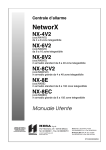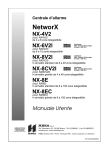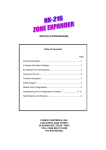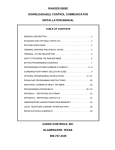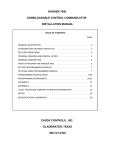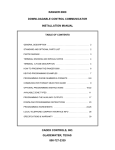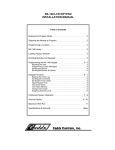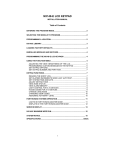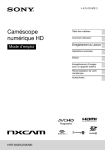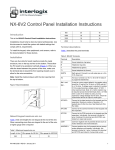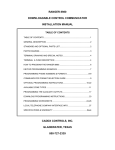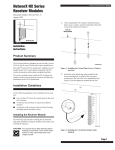Download NX-320 REMOTE POWER SUPPLY INSTALLATION MANUAL
Transcript
NX-320 REMOTE POWER SUPPLY INSTALLATION MANUAL TABLE OF CONTENTS Page General Description................................................................................................. 2 Installing the NX-320 ............................................................................................... 2 Enrolling the NX-320 ............................................................................................... 2 Understanding the LEDs ......................................................................................... 2 Terminal Descriptions.............................................................................................. 3 Programming the NX-320 ....................................................................................... 4 Programming Outputs A - C ..............................................................................4 - 6 Programming Codes 1 - 99 ...............................................................................6 - 7 Programming Worksheets ...............................................................................8 - 10 NX-320 Layout .......................................................................................................10 Specifications and Warranty..................................................................................12 1-800-727-2339 NX-320 REMOTE POWER SUPPLY MODULE GENERAL DESCRIPTION The NX-320 is a microprocessor controlled remote power supply module for the NX-8 control panel. The NX-320 has three (3) programmable outputs and one (1) dedicated bell output. A maximum of four (4) NX320 power supply modules can be added to the NetworX control panel for a total output count of 16, of which 12 are programmable and 4 are dedicated bell outputs. These 12 programmable outputs can be used as auxiliary power, smoke detector power, siren driver power, etc. (see chart on page 4). Each NX-320 has a Tamper terminal that can be used to supervise the metal enclosure. When the NX-320 is connected to the NX-8 control panel, the maximum total wire run from the panel to all devices, including the NX-320, is 2500 feet. Additionally, the maximum total wire run from the NX-320 to all outgoing devices is 2500 feet. INSTALLING THE NX-320 The first thing that must be decided is the address of this particular power supply. This is the address that will be selected when programming the NX-320. To set the address, use the table below. Dip Switch 4 is used to disable the Tamper feature of the NX-320 (“On = enabled / “Off” = disabled). Address Dip switch 1 Dip switch 2 Dip switch 3 84 OFF OFF NA 85 ON OFF NA 86 OFF ON NA 87 ON ON NA ENROLLING THE NX-320 REMOTE POWER SUPPLY The NX-8 has the ability to automatically find and store in its memory the presence of all keypads, zone expanders, wireless receivers and any other module connected to the data terminal. This allows these modules to be supervised by the control panel. To enroll the modules enter the Program Mode of the NX-8 control panel, and when the Program Mode is exited, it will automatically enroll the devices. The enrolling process takes about 12 seconds, during which time the “Service” LED will illuminate. User codes will not be accepted during the enrolling process. Once a module is enrolled, if it is not detected by the control, the “Service” LED will illuminate. UNDERSTANDING THE LEDS The NX-320 has four (4) red LEDs, which provide valuable information about the status of the NX-320. The following chart furnishes the indications of each LED. LED Description DS1 Flashes when data is transmitted out from the NX-320. DS2 Flashes when data is transmitted into the NX-320. DS3 Flashes during normal operation. DS4 Used for hardware, and will only glow dimly when connected to the NX-8 control panel. 2 TERMINAL DESCRIPTIONS Terminal Description DATA Connect to the NX-8 control panel Data terminal. This terminal is the incoming data-signaling terminal to the NX-320. The maximum total wire run from the control panel to all devices, including the NX-320, is 2500 feet. COM Connect to the NX-8 control panel COMMON terminal. This terminal supplies the common side of the power to the NX-320 board. POS Connect to control panel AUX POWER + terminal. This terminal supplies power to the NX-320 board. DATA This terminal is the outgoing data-signaling terminal for buss extension. The maximum total wire run from the NX-320 to all outgoing devices is 2500 feet. COM Common terminal for any device powered from the NX-320. OUT A Programmable output current limited to 1.5 Amps. OUT B Programmable output current limited to 1.5 Amps. Common terminal for any device powered from the NX-320. COM OUT C BELL + BELL TAM EARTH NOTE: The total current of the NX-320 is 2.0 Positive of bell output current limited to 2.5 Amps. Connect as in diagram Amps. on page 10. Programmable output current limited to 1.5 Amps. Negative of bell output current limited to 2.5 Amps. Connect as in diagram on page 10. This is an optional tamper terminal. To use this feature, connect the normally closed tamper switch between this terminal and COM. If switch 4 is off, this feature is not used. Earth Ground. AC AC Input. Connect to a 16.5V 25, 40, or 50 VA Class II UL approved transformer. AC AC Input. Connect to a 16.5V 25, 40, or 50 VA Class II UL approved transformer. WIRING REQUIREMENTS LENGTH WIRE GAUGE (MEASURED IN FEET) WHEN CONNECTED TO NX-8 WHEN CONNECTED TO ANOTHER NX-320 400 24 24 500 24 22 1000 24 20 2000 22 18 2500 20 16 3 PROGRAMMING THE NX-320 The Program Mode is accessed by entering [rr]-[8] (all of the function key LEDs will begin to flash). Enter the "Go To Program" code (default is [9]-[7]-[1]-[3]). If the code was valid, the Service LED will flash, and the function LEDs will illuminate steady, indicating the device to program should be entered. Next, enter the address of the NX-320 (see chart on page 2) followed by [#]. At this point, the Armed LED will illuminate while it is waiting for a programming location to be entered. Enter the desired programming location. The Armed LED will begin to flash while a programming location is being entered. Enter the [#] key. If this is a valid location, the Armed LED will extinguish, the Ready LED will illuminate, and the binary data for the first segment of this location will be shown on the zone LEDS. To change the data, enter the data followed by [rr]. The data will be entered, and the location will automatically increment to the next segment. The data for that segment will be displayed. This procedure is repeated until the last segment is reached. Pressing the [#] key will exit from this location. To review the data, repeat the above procedure, pressing the [rr] key without entering data first. Each time the [rr] key is pressed, the next segment is displayed. Programming data is always one of two types of data. The first type is numerical, and can take on values from 0-255 or 0-15 depending on the segment size. The second type is a feature selection type. Feature selection data is used to turn features on or off. LCD Keypad Users Note: All steps required for programming are the same as the aforementioned LED keypad. The LCD keypad display will prompt you for the data required. While in the programming mode, and not in a location, the number in parenthesis is the location you were previously changing. For example, if the display reads "Enter location, then # (5)", it is reminding you that location 5 was the last location you programmed. In feature selection data, the numbers of the enabled features will be displayed. However, the features not enabled will display a hyphen (-). LOCATION 0 PROGRAMMING THE EVENT & TIME FOR OUTPUT A (1 segment of numerical data) Segment 1 is used to select the particular event that will trigger Output A. See following chart for the specific events that can be selected. Segment 2 is used to select the amount of time an output will remain activated when an output triggers. If this location is programmed as a zero, the output will follow the particular event. # 0 1 Event Always On AC Fail (control or exp.) Does not follow AC Fail delay time # 11 Event Smoke Power Reset # 22 Event Disarmed 12 Yelping Siren 23 Ready to Arm 2 Low Battery (control or exp.) 13 Steady Siren 24 Not Ready to Arm 3 Dynamic Battery Test Time 14 Any Siren 25 Fire 4 Listen In 15 Steady Siren (temporal) 26 Fire Trouble 5 Line Seizure 16 Any Siren (temporal) 27 Chime 6 Telephone Line Fault 17 Alarm Memory 28 Beeping Keypad 7 Program Mode 18 Entry 29F F Aux 1 Keypad Function 8 Over-current (control or exp.) 19 Exit 30F F Aux 2 Keypad Function 9 Box Tamper (control or exp.) 20 Entry or Exit 10 Siren Tamper (control or exp.) 21 Armed 31F F Panic Keypad Function Code Entry (set codes in loc 32F F 8 – 17) F If set to follow condition, these events will be one second. 4 LOCATION 1 data) PROGRAMMING SPECIAL FEATURES FOR OUTPUT A (8 segments of feature selection Segment 1 selects the following special conditions: 1= 2= 3= 4= 5= 6= 7= 8= "On" if output should time in minutes; "Off" if output times in seconds. "On" if output should latch until a code is entered; “Off” for timed. "On" if output should stop time when a code is entered. “On” for inverted output. “On” disables output during listen-in (only events 12-16). Reserved. Reserved. Reserved. Segment 2 selects the following partitions: 1 2 3 4 5 6 7 8 = = = = = = = = "On" if the event should activate when it occurs in Partition 1. "On" if the event should activate when it occurs in Partition 2. "On" if the event should activate when it occurs in Partition 3. "On" if the event should activate when it occurs in Partition 4. "On" if the event should activate when it occurs in Partition 5. "On" if the event should activate when it occurs in Partition 6. "On" if the event should activate when it occurs in Partition 7. "On" if the event should activate when it occurs in Partition 8. LOCATION 2 PROGRAMMING THE EVENT & TIME FOR OUTPUT B (1 segment of numerical data) Segment 1 is used to program the particular event that will trigger Output B. See chart on page 4 for the specific events that can be selected. Segment 2 is used to select the amount of time an output will remain activated when an output triggers. If this location is programmed as a zero, the output will follow the particular event. LOCATION 3 data) PROGRAMMING SPECIAL FEATURES FOR OUTPUT B (8 segments of feature selection Segment 1 selects the following special conditions: 1 2 3 4 5 6 7 8 = = = = = = = = "On" if output should time in minutes; "Off" if output times in seconds. "On" if output should latch until a code is entered; “Off” for timed. "On" if output should stop time when a code is entered. "On" for inverted output. “On” disables output during listen-in (only events 12-16). Reserved. Reserved. Reserved. Segment 2 selects the following partitions: 1 2 3 4 5 6 7 8 = = = = = = = = "On" if the event should activate when it occurs in Partition 1. "On" if the event should activate when it occurs in Partition 2. "On" if the event should activate when it occurs in Partition 3. "On" if the event should activate when it occurs in Partition 4. "On" if the event should activate when it occurs in Partition 5. "On" if the event should activate when it occurs in Partition 6. "On" if the event should activate when it occurs in Partition 7. "On" if the event should activate when it occurs in Partition 8. 5 LOCATION 4 PROGRAMMING THE EVENT & TIME FOR OUTPUT C (1 segment of numerical data) Segment 1 is used to program the particular event that will trigger Output C. See chart on page 4 for the specific events that can be selected. Segment 2 is used to select the amount of time an output will remain activated when an output triggers. If this location is programmed as a zero, the output will follow the particular event. LOCATION 5 data) PROGRAMMING SPECIAL FEATURES FOR OUTPUT C (8 segments of feature selection Segment 1 selects the following special conditions: 1 2 3 4 5 6 7 8 = = = = = = = = "On" if output should time in minutes; "Off" if output times in seconds. "On" if output should latch until a code is entered; “Off” for timed. "On" if output should stop time when a code is entered. "On" for inverted output. “On” disables output during listen-in (only events 12-16). Reserved. Reserved. Reserved. Segment 2 selects the following partitions: 1 2 3 4 5 6 7 8 = = = = = = = = "On" if the event should activate when it occurs in Partition 1. "On" if the event should activate when it occurs in Partition 2. "On" if the event should activate when it occurs in Partition 3. "On" if the event should activate when it occurs in Partition 4. "On" if the event should activate when it occurs in Partition 5. "On" if the event should activate when it occurs in Partition 6. "On" if the event should activate when it occurs in Partition 7. "On" if the event should activate when it occurs in Partition 8. LOCATIONS 6 & 7 RESERVED LOCATION 8 CODES 1-10 OUTPUT ENABLE (10 segments of feature selection data) When activating outputs with a user code (event #30), location 8 can be used to restrict certain codes from activating certain outputs. Location 8 contains 10 segments. Segment 1 corresponds to user 1; Segment 10 corresponds to user 10. The LEDs correspond to outputs A - C. LED DESCRIPTION 1 "On" if code will activate Output A; "Off" if it will not. 2 "On" if code will activate Output B; "Off" if it will not. 3 "On" if code will activate Output C; "Off" if it will not. Reserved. 4 LOCATION 9 CODES 11-20 OUTPUT ENABLE (10 segments of feature selection data) When activating outputs with a user code (event #30), location 9 can be used to restrict certain codes from activating certain outputs. Location 9 contains 10 segments. Segment 1 corresponds to user 11; Segment 10 corresponds to user 20. The LEDs correspond to outputs A - C (see chart above). LOCATION 10 CODES 21-30 OUTPUT ENABLE (10 segments of feature selection data) When activating outputs with a user code (event #30), location 10 can be used to restrict certain codes from activating certain outputs. Location 10 contains 10 segments. Segment 1 corresponds to user 21; Segment 10 corresponds to user 30. The LEDs correspond to outputs A - C (see chart above). 6 LOCATION 11 CODES 31-40 OUTPUT ENABLE (10 segments of feature selection data) When activating outputs with a user code (event #30), location 11 can be used to restrict certain codes from activating certain outputs. Location 11 contains 10 segments. Segment 1 corresponds to user 31; Segment 10 corresponds to user 40. The LEDs correspond to outputs A - C (see chart above). LOCATION 12 CODES 41-50 OUTPUT ENABLE (10 segments of feature selection data) When activating outputs with a user code (event #30), location 12 can be used to restrict certain codes from activating certain outputs. Location 12 contains 10 segments. Segment 1 corresponds to user 41; Segment 10 corresponds to user 50. The LEDs correspond to outputs A - C (see chart above). LOCATION 13 CODES 51-60 OUTPUT ENABLE (10 segments of feature selection data) When activating outputs with a user code (event #30), location 13 can be used to restrict certain codes from activating certain outputs. Location 13 contains 10 segments. Segment 1 corresponds to user 51; Segment 10 corresponds to user 60. The LEDs correspond to outputs A - C (see chart above). LOCATION 14 CODES 61-70 OUTPUT ENABLE (10 segments of feature selection data) When activating outputs with a user code (event #30), location 14 can be used to restrict certain codes from activating certain outputs. Location 14 contains 10 segments. Segment 1 corresponds to user 61; Segment 10 corresponds to user 70. The LEDs correspond to outputs A - C (see chart above). LOCATION 15 CODES 71-80 OUTPUT ENABLE (10 segments of feature selection data) When activating outputs with a user code (event #30), location 15 can be used to restrict certain codes from activating certain outputs. Location 15 contains 10 segments. Segment 1 corresponds to user 71; Segment 10 corresponds to user 80. The LEDs correspond to outputs A – C (see chart on page 6). LOCATION 16 CODES 81-90 OUTPUT ENABLE (10 segments of feature selection data) When activating outputs with a user code (event #30), location 16 can be used to restrict certain codes from activating certain outputs. Location 16 contains 10 segments. Segment 1 corresponds to user 81; Segment 10 corresponds to user 90. The LEDs correspond to outputs A - C (see chart on page 6). LOCATION 17 CODES 91-99 OUTPUT ENABLE (9 segments of feature selection data) When activating outputs with a user code (event #30), location 17 can be used to restrict certain codes from activating certain outputs. Location 17 contains 9 segments. Segment 1 corresponds to user 91; Segment 9 corresponds to user 99. The LEDs correspond to outputs A - C (see chart on page 6). LOCATION 18 A/C DELAY AND DYNAMIC BATTERY TEST (2 segments of feature selection data) Location 18 is used to enable the A/C delay and the Dynamic Battery Test, both of which are timed in minutes. The factory default is 5-0, meaning the A/C power will be off for 5 minutes before a report is sent or a Service light will illuminate, and the Dynamic Battery Test is disabled (“0” minutes). If you desire the A/C delay to be 8 minutes and the Dynamic Battery Test to be 3 minutes, you would program [8]-[3]. LOCATION 19 DEVICE OPTIONS (8 segments of feature selection data) Location 19 is used to enable various system features of the NX-320 power supply. LED 1 2 3 4 5-8 Description On for AC report always sent; Off follows control § If enabled, an AC Fail report will be sent if power is lost for the time programmed in Location 18. If “off”, the report will only be sent if the control panel has not sent an AC Power Lost report, and AC Fail report is enabled in Location 37. On enables periodic Battery Test § Enables Battery Missing every 30 seconds. On enables Low Battery reporting § If enabled, the NX-320 will report Low Battery to the central station. On enables Siren Tamper/Trouble reporting § If enabled, the NX-320 will report a Siren Tamper to the central station. Reserved 7 NetworX NX-320 Programming Worksheets (Defaults are printed in bold italics text.) At Default: Output A = AUX POWER, Output B = AUX POWER, Output C = SMOKE POWER LOC PAGE DESCRIPTION DEFAULT DATA 0 1 4 5 OUTPUT A EVENT & TIME OUTPUT A SPECIAL FEATURES Segment 1 1 = "On" if timed in minutes; "Off" if timed in seconds. 2 = "On" if latched until code is entered; “Off” for timed. 3 = "On" if output should stop time when a code is entered. 4 = "On" for inverted output. 5 = “On” disables output during listen-in. 6-8 = Reserved 0 10 _ _ 2 4 3 5 4 6 5 6 6&7 6 OUTPUT B EVENT & TIME OUTPUT B SPECIAL FEATURES Segment 1 1 = "On" if timed in minutes; "Off" if timed in seconds. 2 = "On" if latched until code is entered; “Off” for timed. 3 = "On" if output should stop time when a code is entered. 4 = "On" for inverted output. 5 = “On” disables output during listen-in. 6-8 = Reserved. OUTPUT C EVENT & TIME OUTPUT C SPECIAL FEATURES Segment 1 1 = "On" if timed in minutes; "Off" if timed in seconds. 2 = "On" if latched until code is entered; “Off” for timed. 3 = "On" if output should stop time when a code is entered. 4 = "On" for inverted output. 5 = “On disables output during listen-in. 6-8 = Reserved. RESERVED. 8 Segment 2 1 = Partition 1 2 = Partition 2 3 = Partition 3 4 = Partition 4 0 10 Segment 2 1 = Partition 1 2 = Partition 2 3 = Partition 3 4 = Partition 4 11 8 Segment 2 1 = Partition 1 2 = Partition 2 3 = Partition 3 4 = Partition 4 5 = Partition 5 6 = Partition 6 7 = Partition 7 8 = Partition 8 _ _ 5 = Partition 5 6 = Partition 6 7 = Partition 7 8 = Partition 8 _ _ 5 = Partition 5 6 = Partition 6 7 = Partition 7 8 = Partition 8 LOC 8 9 10 11 12 13 14 15 16 17 PAGE 6 6 6 7 7 7 7 7 7 7 DESCRIPTION Codes 1-10 Output Enable (Circle the numbers to program) User 1 2 3 4 5 6 7 Output #A 1 1 1 1 1 1 1 Output #B 2 2 2 2 2 2 2 Output #C 3 3 3 3 3 3 3 Codes 11-20 Output Enable (Circle the numbers to program) User 11 12 13 14 15 16 17 Output #A 1 1 1 1 1 1 1 Output #B 2 2 2 2 2 2 2 Output #C 3 3 3 3 3 3 3 Codes 21-30 Output Enable (Circle the numbers to program) User 21 22 23 24 25 26 27 Output #A 1 1 1 1 1 1 1 Output #B 2 2 2 2 2 2 2 Output #C 3 3 3 3 3 3 3 Codes 31-40 Output Enable (Circle the numbers to program) User 31 32 33 34 35 36 37 Output #A 1 1 1 1 1 1 1 Output #B 2 2 2 2 2 2 2 Output #C 3 3 3 3 3 3 3 Codes 41-50 Output Enable (Circle the numbers to program) User 41 42 43 44 45 46 47 Output #A 1 1 1 1 1 1 1 Output #B 2 2 2 2 2 2 2 Output #C 3 3 3 3 3 3 3 Codes 51-60 Output Enable (Circle the numbers to program) User 51 52 53 54 55 56 57 Output #A 1 1 1 1 1 1 1 Output #B 2 2 2 2 2 2 2 Output #C 3 3 3 3 3 3 3 Codes 61-70 Output Enable (Circle the numbers to program) User 61 62 63 64 65 66 67 Output #A 1 1 1 1 1 1 1 Output #B 2 2 2 2 2 2 2 Output #C 3 3 3 3 3 3 3 Codes 71-80 Output Enable (Circle the numbers to program) User 71 72 73 74 75 76 77 Output #A 1 1 1 1 1 1 1 Output #B 2 2 2 2 2 2 2 Output #C 3 3 3 3 3 3 3 Codes 81-90 Output Enable (Circle the numbers to program) User 81 82 83 84 85 86 87 Output #A 1 1 1 1 1 1 1 Output #B 2 2 2 2 2 2 2 Output #C 3 3 3 3 3 3 3 Codes 91-99 Output Enable (Circle the numbers to program) User 91 92 93 94 95 96 97 Output #A 1 1 1 1 1 1 1 Output #B 2 2 2 2 2 2 2 Output #C 3 3 3 3 3 3 3 9 8 1 2 3 9 1 2 3 10 1 2 3 18 1 2 3 19 1 2 3 20 1 2 3 28 1 2 3 29 1 2 3 30 1 2 3 38 1 2 3 39 1 2 3 40 1 2 3 48 1 2 3 49 1 2 3 50 1 2 3 58 1 2 3 59 1 2 3 60 1 2 3 68 1 2 3 69 1 2 3 70 1 2 3 78 1 2 3 79 1 2 3 80 1 2 3 88 1 2 3 89 1 2 3 90 1 2 3 98 1 2 3 99 1 2 3 LOC 18 PAGE 7 19 7 DESCRIPTION DEFAULT A/C Delay (in minutes) 5 Dynamic Battery Test (in minutes) 0 Device Options (Circle the numbers to program) 1=On for AC report always sent; Off 5=Reserved follows control 6=Reserved 2=On enables periodic battery test 7=Reserved 3=On enables low battery reporting 8=Reserved 4=On enables siren tamper/trouble reporting DATA ___ ___ NX-320 LAYOUT MAXIMUM WIRE RUNS Length in Feet Wire Gauge From NX-8 Control Panel Wire Gauge Daisy Chain to another NX-320 400 24 24 500 24 22 1000 24 20 2000 22 18 2500 20 16 10 ENCLOSURE DIAGRAM Inside the can, several 2-holed insertion points have been constructed. This allows for either vertical or horizontal placement of the modules. Notice that the insertion points have two sizes of holes -- a larger hole and a smaller hole. Diagram 1: The black plastic PCB guides are grooved on one edge where the PC Board will be seated. The end with the half-moon protrusion fits into the larger hole. The smaller hole is for the screw. Diagram 2: Place the first black plastic PCB guide in the top insertion point, grooved edge downward. The half-moon protrusion will be in the large hole. It does not require force. Insert one of the provided screws into the smaller hole (from inside the can) to secure it in place. A screwdriver should reach through the notch that runs the length of the guide to tighten the screw. The second PCB guide should be positioned opposite of the first (grooved edge up) and placed in the lower insertion point, using the same procedures described above. Once mounted, screw it in securely. Diagram 3: The PC board should slide freely in the grooves of both guides. SYSTEM NOTES 11 SPECIFICATIONS NX-320 DIMENSIONS 2” Wide 9” High 4” Deep CURRENT DRAW 10 mA Standby 16.5 VAC 40 or 50 VA Transformer AUXILIARY POWER Limited to 2.0 Amps with 50 VA Limited to 1.5 Amps with 40 VA OPERATING TEMPERATURE 32 to 120 degrees F SHIPPING WEIGHT 8 lbs. FIVE YEAR LIMITED WARRANTY CADDX CONTROLS, INC. GUARANTEES THIS PRODUCT AGAINST DEFECTIVE PARTS AND WORKMANSHIP FOR TWENTY-FOUR (24) MONTHS FROM DATE OF MANUFACTURING. IF ANY DEFECT APPEARS DURING THE WARRANTY PERIOD, RETURN IT TO CADDX, POSTAGE PREPAID. THE UNIT WILL BE REPAIRED AND RETURNED WITHOUT CHARGE. FOR THE REMAINING 36 MONTHS OF WARRANTY, THE CHARGE TO REPAIR OR REPLACE THIS MODULE WILL NOT EXCEED $10.00 PLUS SHIPPING AND HANDLING. CADDX ASSUMES NO LIABILITY FOR CONSEQUENTIAL OR INDIRECT DAMAGE AND ACCEPTS NO RESPONSIBILITY FOR REPAIRING DAMAGE TO THE PRODUCT CAUSED BY MISUSE, CARELESS HANDLING, OR WHERE REPAIRS HAVE BEEN MADE BY OTHERS. NO OTHER GUARANTEE, WRITTEN OR VERBAL, IS AUTHORIZED BY OR ON BEHALF OF CADDX CONTROLS, INC., GLADEWATER, TEXAS. CADDX CONTROLS, INC. 1420 NORTH MAIN STREET GLADEWATER, TEXAS 75647 TOLL FREE 800-727-2339 FAX 903-845-6811 www.caddx.com NX-320 INSTALLATION MANUAL NX320IB98 REV B (9-20-98)












